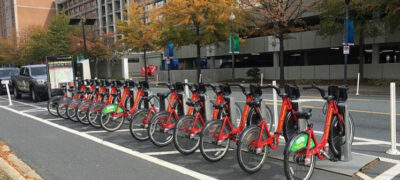Micromobility has proven to be an effective car-free mode of travel in urban areas, yet there is limited guidance on micromobility that is targeted toward smaller cities and rural areas. This Guidebook explored micromobility use cases in non-traditional settings to offer insight on how transit agencies and local jurisdictions could implement similar programs to support their transit services. This section summarizes key findings from the Guidebook.
5.1 Key Findings
5.1.1 Interface with Public Transit and Partnerships
One of the foremost problems in transit planning in small urban, tribal, and rural settings are the large distances between transit services and potential users’ trip origins and destinations. When this distance is longer than one-half mile (a typical ten-minute walk), many potential riders will not use transit. However, due to low development densities of many small urban, tribal, and rural settings, it usually is not economically feasible to run transit services frequently and directly to all of the places people live and activity centers they visit. Micromobility, when implemented correctly and with some degree of integration with transit, is a potential solution to expand the reach of public transit.
Micromobility and transit can be integrated in various forms:
- Physical integration includes when cycle lanes connect to transit or there are docks or secure parking for personal and shared micromobility at transit facilities.
- Informational and digital integration includes physical wayfinding markers directing riders between modes and/or a rider’s trip-planning app suggesting a transit route that incorporates a shared micromobility mode.
- Fare integration is when there is a common payment method between modes or there is a discount (partial or full) for transferring between transit and micromobility.
- Finally, the highest level is institutional integration, wherein one agency is responsible for managing multiple modes.
Institutional integration can vary by degree, ranging from partnerships to consolidated operations. For example, CATA in Meadville, Pennsylvania, and the RTA in Dayton, Ohio, both directly operate micromobility programs; they are responsible for all operations and management. To a lesser degree, CARTA in Chattanooga, Tennessee, partners with the non-profit that operates the bikeshare there to support grant applications, bikeshare station placement near bus stops, and has a stored-value payment card that works for transit and bikeshare. The lowest level of integration is through permitting and private partnerships, whereby transit agencies and other government agencies can mandate certain conditions in exchange for allowing a private micromobility company to operate in their jurisdiction or on their property.
5.1.2 Factors for Success
Various factors affect demand for micromobility services: higher population and employment density, more mixed-use land uses, lower average trip lengths, tourist and leisure destinations, and infrastructure availability are key drivers. Before establishing a micromobility program, it is important to examine jurisdictional, user, and vendor considerations for feasibility.
From a jurisdictional perspective, it is important to examine:
- Funding availability for startup costs and future operations and maintenance.
- Pedestrian and bicycle infrastructure availability.
- The presence of local partners to support the program.
- The level of support from local residents, businesses, politicians, and city agencies.
- Whether adequate staffing is available.
- What considerations will be made for accessibility.
User considerations to examine include:
- The locations of docking stations.
- Safety when using the system.
- Connections with other modes.
- Ease of use and payment.
- General convenience/ways to ensure a quality user experience.
Vendors must consider whether the market in an area will provide a financially sustainable business model, and if not, if they can partner with transit agencies or other local organizations/government agencies to access long-term, stable funding to subsidize the program.
5.1.3 Ownership, Governance, and Regulation
Micromobility systems can have several business models depending on who owns and operates the program. Typically, the program owner is either a non-profit, a public entity (including transit agencies), or a private firm. The operator is either the owner, a third-party contractor, or some hybrid operations model wherein certain functions are handled by different parties. In smaller communities, lower levels of density and associated lower ridership often mean that entirely private systems are not financially viable, and some sort of public funding, private sponsorship, and/or non-profit operations may be required to make a system viable.
Oftentimes, systems in smaller jurisdictions rely on donated or cheaply purchased used equipment for startup. For continued operations and maintenance, they often rely on volunteers and partnerships with local bike shops or other community organizations. Outsourcing certain functions this way is important to helping the system work with limited resources and staff availability. Community bike libraries, run by non-profits, public libraries, or other government agencies, are another model to consider for smaller communities. In these systems, users can check-out a bike for free for a predetermined period of time with only an ID or library card; usually they are funded publicly or through donations.
An organized program governance model is important for providing a framework for decision making, roles, and responsibilities, especially when a system has multiple stakeholders involved. In some instances, one agency may play a lead role, in others, a new non-profit organization may be formed to unite multiple stakeholders and ease grant applications and funding issues. Especially for privately owned or operated systems, regulations are an important way to ensure that the system is aligned with public policy objectives. Common areas for regulation include where services can operate, how big their fleets can be, parking location requirements, safety requirements, data sharing and reporting, insurance requirements, and vehicle distribution requirements.
5.1.4 Technology and Organizational Requirements
Agencies require varied skills to deploy and monitor micromobility programs depending on the ownership and operations model. From a technology standpoint, agencies need to be familiar with industry data standards and data processing, as well as integrating micromobility into fare payment services, trip planners, and other ways to make transit and micromobility work together seamlessly. From an organizational standpoint, agencies may need to be able to navigate vendor procurement, hiring and staffing requirements, resources required for program operations and maintenance, and coordination with local jurisdictions for permitting and regulations.
The agency must also be able to manage the various risks and liabilities that come with operating or managing micromobility. From a legal and financial perspective, there are insurance requirements, concerns requiring data privacy and security, user safety liability, as well as possible future Title VI and other legal requirements. From a customer standpoint, there are concerns regarding accessibility, affordability, privacy, and ease of use. Finally, there are institutional risks coming from the nature of micromobility being a novel and volatile industry, risks of staffing and knowledge shortages, reputational risks, and the costs and funding impacts of the program.
5.2 Areas of Further Research
There were several areas of inquiry that the research team sees as knowledge gaps, either due to the lack of research, data, or on-the-ground examples:
- The research team was unable to find any literature regarding micromobility systems operating in tribal areas other than a few news articles about a brief LimeBike program in the Reno-Sparks Indian Colony in Nevada, which is no longer operating.
- All scootershare systems found were privately owned and operated, with the exception of Dayton RTA’s system. There are limited examples of publicly owned and operated scootershare services.
- There is very little guidance on data collection for small systems, especially bike libraries; this data would be useful for determining why and how people are using the system and allowing the agency to plan accordingly.
- More information would be helpful regarding opportunities for smaller communities to upcycle used equipment from private operators or larger jurisdictions.
Further research on different partnership approaches could provide strategies that would allow smaller systems to more easily acquire and share resources across multiple systems to achieve greater scale and effectively leverage smaller budgets and staffing.

